Mark Sisson's Blog, page 263
April 29, 2015
For a Limited Time Only: The Year’s Biggest Deal from Mark’s Daily Apple (Expires May 6)
 Today, I’m releasing two brand new Primal Blueprint eBooks and giving away several gifts as part of a special offer for Mark’s Daily Apple readers (you!). The offer lasts just one week (April 29-May 6). You won’t want to miss it. But more on that in a moment…
Today, I’m releasing two brand new Primal Blueprint eBooks and giving away several gifts as part of a special offer for Mark’s Daily Apple readers (you!). The offer lasts just one week (April 29-May 6). You won’t want to miss it. But more on that in a moment…
One of the primary challenges to living a primal-adapted lifestyle is accessibility. Make that affordability and accessibility. One of the constant refrains I hear from Groks and Grokettes is “I just don’t have access to primal-friendly foods in my small town” or “paleo foods are so much more expensive that it’s hard to stay on track.”
I hear you…and that’s partly why I invested in Thrive Market, an online health food co-op that takes accessibility and affordability out of the equation (we’re talking Whole Foods products with Costco prices but in everyday sizes). For a ridiculously low monthly membership (just $5) you gain access to more than 4,000 of the highest quality, certified organic primal/paleo-friendly foods on the planet, all at 25-50% off retail prices. You can stock up on certified-organic, and even fair-trade foods with no hassle or guesswork, and shop for paleo-approved supplements, home goods, cleaning supplies, body care, and beauty staples while you’re at it.
How is Thrive able to get you such great deals? Because they don’t mark up their retail prices like other stores do, but instead use a low-cost annual membership fee ($59.95, just $5 a month) to cover costs so that they can pass wholesale savings directly on to you. My annual membership fee was more than covered in savings on my first order, and yours probably will be too. To see for yourself, dig up some of your most recent shopping receipts and then explore the online shelves of Thrive Market to see what you’d save.
Thrive Gives and You Get
In addition to saving you guys money and making the primal lifestyle accessible to all, I was also called upon to invest in Thrive Market because I believe in its commitment to sustainability and its socially conscious Thrive Gives program. For every paid membership Thrive receives, it gives a free membership to a low-income family in need. And that need is great…49 million Americans experience food insecurity, and 80% of low-income families eat unhealthy foods in order to make ends meet. Many low-income neighborhoods don’t have natural, healthy food options to begin with. Your Thrive Market membership opens up the doors to healthy living foods, home, and baby products for a family looking to thrive.
And while we’re making the world healthier one family at a time, we’re also helping the environment. Thrive partners with eco-friendly vendors on a shared mission and boasts a 100% carbon neutral footprint through carbonfund.org. All packaging, boxes, and inserts are made from recyclable paper and are recyclable.
A Mark’s Daily Apple Exclusive Deal

Click the image above to visit Thrive Market and watch the video
I strongly believe in the Thrive mission and program, so I put together a promotional deal for all Mark’s Daily Apple readers in case you’re still on the fence.
It’s two-fold:
1. Register today and you’ll be entered to win a $500 shopping spree to Thrive Market. Who couldn’t use $500 in primal foods? (No purchase required to register.)
2. Order anything from Thrive Market—may I suggest a jar of Primal Kitchen™ Mayo—and you’ll get you a 2-month FREE trial to Thrive and a $10 off coupon for your first order (minimum $50 order)—that’s in addition to the already included 25-50% discounts you’ll enjoy as a Thrive member. You can cancel at anytime if you aren’t sold, but I think you’ll be fully on board after your first purchase.
But that’s not all. Immediately following your purchase you’ll receive an email that delivers all of these gifts directly to your inbox:
1. $10 Coupon to PrimalBlueprint.com
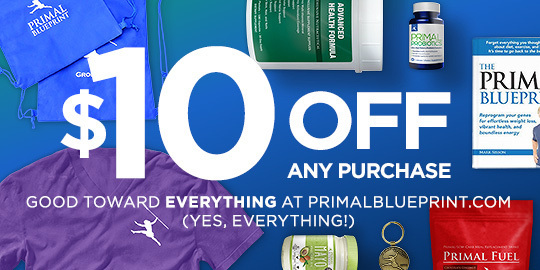
You can use this $10 coupon to purchase any Primal Blueprint supplement, book, or product on PrimalBlueprint.com. It essentially takes care of the cost of your Mayo (or any other product under $10 at Thrive Market). If that’s not a deal, I don’t know what is!
2. The Primal Blueprint Definitive Guide to Sun Exposure and Vitamin D Health (eBook)
I’ve amassed the latest findings on vitamin D research and put together this exclusive guide for everything you need to know about healthy sun exposure and vitamin D. This never-before-released eBook is only available as part of this promo and is yours for free so don’t miss it!
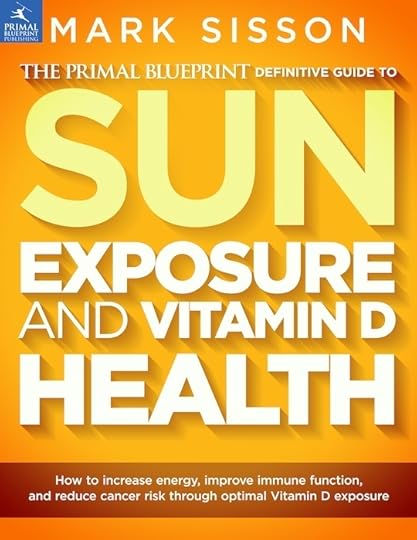
Sample pages:
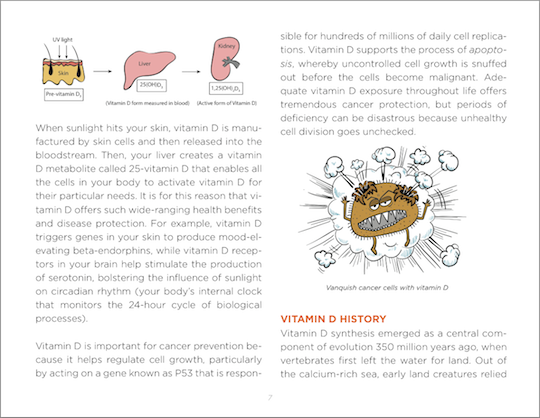
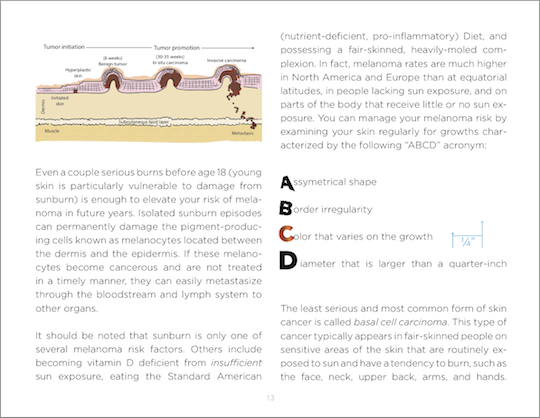
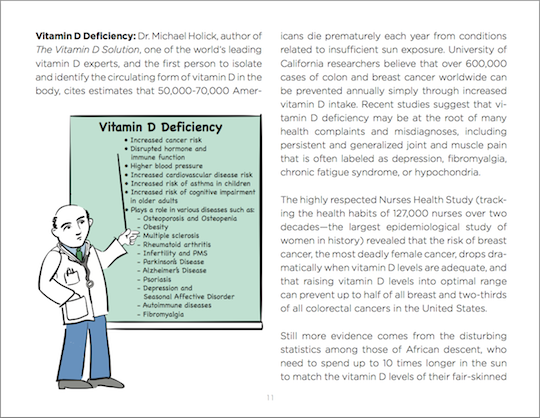
3. Amazing Feets! – How to Safely and Enjoyably Transition to a Barefoot-Dominant Lifestyle (eBook)
This is a must-read for the modern caveman/woman and is also only available with this offer. I break down the safest way to transition to a barefoot-dominate lifestyle, thereby reducing your risk of chronic pain and injury to your feet, and improving your walking/running technique, balance, explosiveness, speed, endurance, and kinesthetic awareness, as well as recalibrating your entire musculoskeletal alignment.

Sample pages:
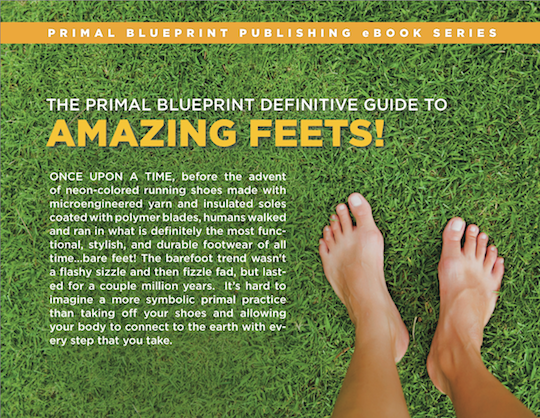
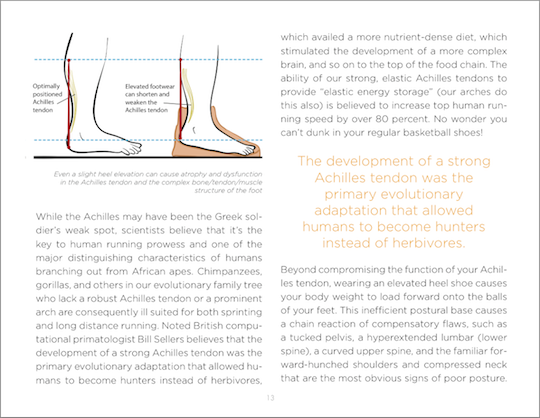
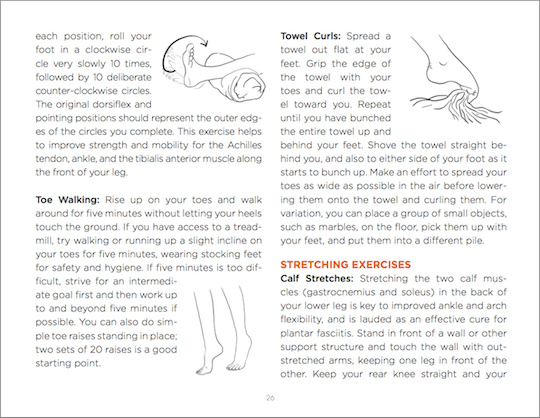
4. Primal Blueprint Healthy Sauces, Dressings & Toppings (eBook)
I’m giving away my top-selling cookbook for free in PDF format with this deal. In it I include the essential list of Primal-approved ingredients you need to create your dips, rubs, dessert toppings, marinades, seasonings, salsa, pesto, flavored butter, tapenade, gravy and much more…and you can buy all the ingredients you need at discount prices at Thrive Market. There are tons of recipes that call for Primal Mayo, so you’re all set for ways to reintroduce a healthy mayo back into your primal life, a mayo that includes delicious and healthful avocado oil.
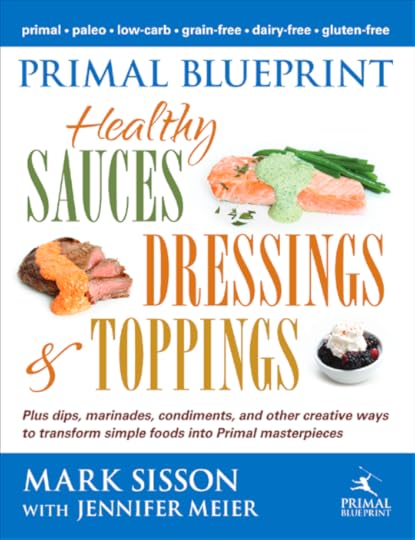
Sample pages:
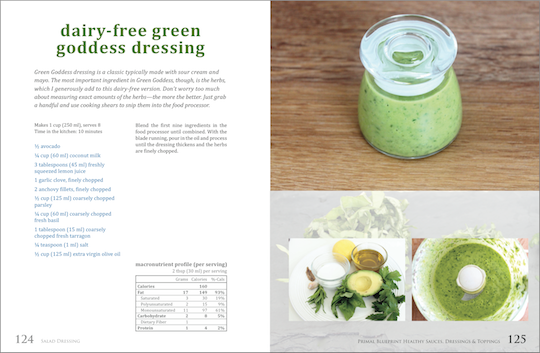
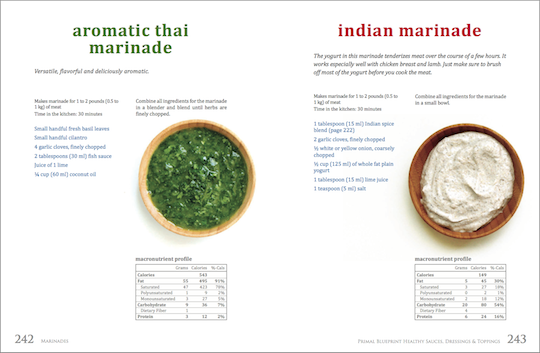
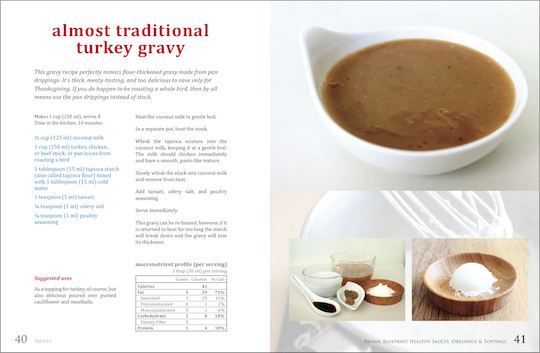
5. Primal Kitchen Mayo eCookbook
This brand new eCookbook features delectable recipes from the world’s most creative paleo/primal chefs…and the key ingredient is Primal Kitchen’s Mayo, which you can buy straight from the online shelves of Thrive Market. We’ve included recipes like Madras Chicken Salad from NomNom Paleo and Paleo Spinach & Artichoke Crab Dip from Paleo Schmaleo.

Sample pages:
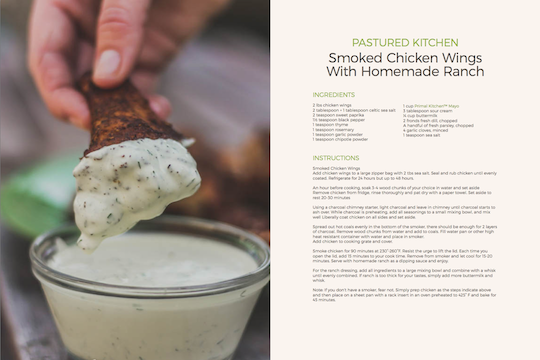
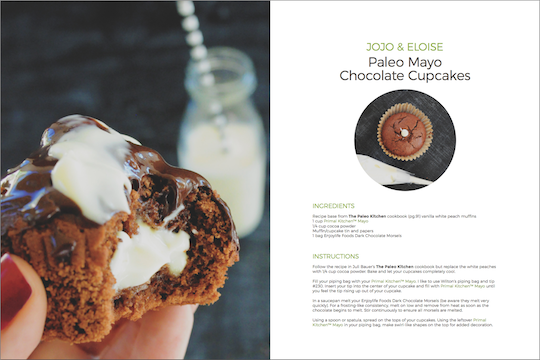
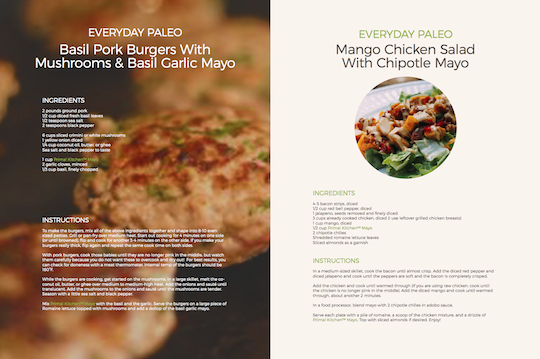
To recap:
Click this link and buy anything on Thrive Market by May 6 and you’ll get:
2-Month Free Membership to Thrive Market
$10 Off Your First Order at Thrive Market ($50 minimum order)
$10 Off Coupon to PrimalBlueprint.com
The Primal Blueprint Definitive Guide to Sun Exposure and Vitamin D Health (eBook)
Amazing Feets! – How to Safely and Enjoyably Transition to a Barefoot-Dominant Lifestyle (eBook)
Primal Blueprint Healthy Sauces, Dressings & Toppings (eBook)
Primal Kitchen Mayo eCookbook
Oh, and when you register, you’ll be entered to win a $500 shopping spree to Thrive Market.
With thousands of products to choose from I’m sure you’ll find something you need. Plus, you get free shipping and handling on orders of $50 or more!
I hope you’ll Thrive with me on this primal journey of ours!
Claim FREE 2-Month Membership and Gifts Galore Today!>>
Fine print:
You don’t need to spend $50 at Thrive Market to get free gifts. The $50 minimum order only applies to the “$10 Off Your First Order” gift.
If you’re already a Thrive Market member, you can still get all the free gifts listed above except for the “$10 Off Your First Order” gift.
All of the free gifts will be delivered to you by email immediately after you place your order.
The PrimalBlueprint.com coupon expires on May 31, 2015. Minimum order of $10.01.
This offer runs through May 6, 2015 and expires at 11:59 PDT.

Prefer listening to reading? Get an audio recording of this blog post, and subscribe to the Primal Blueprint Podcast on iTunes for instant access to all past, present and future episodes here.



April 28, 2015
Do Low-Carb Diets Cause Insulin Resistance?
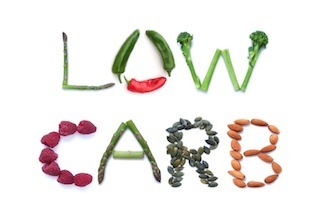 A few weeks back in the “How to Improve Your Insulin Sensitivity” post, I apparently dropped a bit of a bombshell: that very low carb diets can induce insulin resistance. Many of you wrote to me asking about the effects of low-carb dieting on insulin sensitivity and wondering whether you should begin eating more carbohydrates to counter it. Well, maybe, but there’s a right way and a wrong way to eat carbs if you’re low carb. The wrong way is to just add a ton of carbohydrates on top of your low-carb Primal eating plan without changing anything else. Doing that, especially in perpetuity, will likely lead to weight gain, hyperinsulinemia, and even more insulin resistance. Bad all around.
A few weeks back in the “How to Improve Your Insulin Sensitivity” post, I apparently dropped a bit of a bombshell: that very low carb diets can induce insulin resistance. Many of you wrote to me asking about the effects of low-carb dieting on insulin sensitivity and wondering whether you should begin eating more carbohydrates to counter it. Well, maybe, but there’s a right way and a wrong way to eat carbs if you’re low carb. The wrong way is to just add a ton of carbohydrates on top of your low-carb Primal eating plan without changing anything else. Doing that, especially in perpetuity, will likely lead to weight gain, hyperinsulinemia, and even more insulin resistance. Bad all around.
Now, many people are perfectly happy on a perpetually low-carb diet. I function quite well on a low (but not very low) glucose diet, hovering around 100-150 grams a day and often dipping below that. I might go even lower if I didn’t love vegetables and berries so much. But, assuming you are experiencing physiological insulin resistance caused by a very low carb or ketogenic diet, what happens when you do want to incorporate carbohydrates in your diet?
What if you want to pursue high intensity training or high performance goals that your current diet isn’t supporting?
What if you’d like to try out a few more carbs on your ketogenic diet — is such a thing even possible?
What if you need to take — and pass — an oral glucose tolerance test (OGTT)?
How do you eat the carbs, get the benefits, and avoid or limit the negative effects that normally accompany carb consumption in an insulin-resistant state?
I want to support higher-intensity training and performance, but I’m low carb.
Although many people following a lower carb Primal eating plan find that their training performance improves across the board, those seeking the upper echelons of high-intensity, glycogen-dependent performance usually need to regularly consume a somewhat concentrated source of glycogen substrates. How does a physiologically insulin resistant low-carber momentarily increase insulin sensitivity to support higher carb consumption for training?
This one’s really simple, actually, because the problem is the solution: they support their training and improve their carb tolerance by training really hard. High-intensity training, whether weight lifting or sprints or intervals or CrossFit, is a potent inducer of increased insulin sensitivity. You could take one of the most insulin resistant populations around (type 2 diabetics), have them do a few 30 second all-out sprints on a bike with 4 minutes of rest, and see big improvements in insulin sensitivity. HIIT turns your body into a metabolic furnace. It increases the capacity of your skeletal muscle to burn both fat and carbohydrates. That’s why whenever a person asks me about stalled weight loss or stubborn fat, I ask “Are you sprinting?”
I want to eat more carbs, but I’m on a ketogenic diet.
What you want is a cyclical ketogenic diet. Cycling in and out of ketosis with carb-rich forays can support high intensity training and performance while maintaining the benefits of ketogenic dieting, but these cyclical ketogenic diets (CKDs) must be done correctly. Just “eating more carbs” on top of your regular ketogenic diet doesn’t really work for most people. Also, make sure you’re the right audience; cyclical ketogenic diets are meant for people who train, and train often. If your idea of training (or if you’re injured or otherwise unable to train much) is a brisk walk every day, that’s perfectly fine, but you’re probably not a good candidate for a cyclical ketogenic diet because CKDs require glycogen depletion.
There are two basic ways to construct a ketogenic diet that includes carbs: with one big weekly carb load (the classic CKD) or multiple smaller carb loads adjacent to training sessions (often called the targeted ketogenic diet, or TKD).
On a CKD, you spend the majority of the week and your workouts in ketosis and devote a day or a pair of days to eat lots of carbs. You might be ketogenic Monday through Friday, exercising all the while and capping the work week off with a really intense glycogen-depleting training session, then go high-carb, low-fat Saturday through Sunday to refill your depleted and newly-insulin sensitive muscle glycogen stores.
On a TKD, you spend the majority of your time in ketosis but selectively eat carbohydrate before, during, and/or after your workouts. Most people seem to benefit most from pre- and peri-workout carbs. These aren’t large carb loads — 15-30 grams of relatively fast-absorbing, simple carbs. If you don’t want to opt for dextrose or other powders, a baked potato works well.
Whatever option you choose, you’ll need to deplete glycogen if you want to include carbs in a ketogenic diet. As long as you have a glycogen debt, any carbs you eat will go toward restoring those glycogen stores and won’t interfere with ketone production.
I want to pass an oral glucose tolerance test.
In mammals, pregnancy slightly increases insulin resistance and glucose intolerance to reduce nutrient uptake by the mother and preserve it for the growing fetus. This is normal and healthy and important. We do it for the kids. But too much maternal glucose intolerance means too high a nutrient flow to the fetus, prompting excessive growth and potentially untenable (and painful or even dangerous) birthing logistics. To avoid this situation, to head it off at the pass, pregnant women are given a sickly sweet drink containing 75-100 grams of pure glucose, which they must drink on an empty stomach. Their blood sugar levels are monitored at 1 and 2 hours after downing the nasty stuff. If you hit 140 mg/dl or higher at an hour, you’re in the danger zone of prediabetes and have to take further tests.
Low-carbers are at risk of failing these tests because of the low-carb-induced physiological insulin resistance. Luckily, there’s an easy fix:
For three days leading up to the test, eat at least 150 grams of carbs a day. This will increase the activity of your carb metabolizing machinery and smooth out any low-carb-induced insulin resistance. You’ll probably want to drop fat a bit to accommodate the extra calories.
Side note: if you’re pregnant and craving carbs, eat them. Don’t neglect the needs and desires of your body. Just try to stick with better quality carbs (potatoes, sweet potatoes, and other tubers, fruit, well-prepared low-toxin rice) and limit/avoid low quality carbs (bread, pasta, and other grains, pastries, cookies, potato chips, crackers, etc). Your body (and the tiny growing body you’re carrying) may very well need more carbohydrates, but it doesn’t need the trans-fat, sugar, gluten, and other junk that accompany conventional “carb” sources. I always want to throw this in so pregnant women and their partners don’t feel burdened to conform to some very low-carb ideal even as their bodies are crying for the opposite.
If you’re still freaking out about Primal eating making you insulin-resistant, take a breath. Chances are you’re not. Most people eating Primal are eating tons of vegetation and getting around 100-150 grams of carbs from that vegetation, which is plenty to stay insulin sensitive. It’s usually only when you dip down below 50 grams, start flirting with ketosis, and relying entirely on fat and fat-based fuels for energy that insulin resistance occurs. And when that happens, it’s for a very good reason — to preserve glucose for the part of the body that truly needs it: your brain.
Insulin resistance isn’t such a big deal when you don’t have loads of insulin floating around and the good thing about the Primal way of eating is that it reduces the insulin load. What do you know? The overall insulin load goes down when you eat fewer foods that require large amounts of insulin. Again and again, studies that put folks on low-carb diets find that they almost always lead to lower insulin levels. If you’re not encountering loads of insulin, being a little insulin resistant isn’t the mortal danger we often assume it to be.
Thanks for reading, everyone. I hope those people who were worried feel better, and those who wanted to include more carbs in their low-carb or ketogenic diets feel empowered and able to do it.




April 27, 2015
Dear Mark: Osteoporosis, Body Fat Gain on Caloric Deficit, and Stalling on Primal
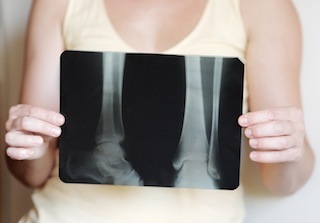 For today’s edition of Dear Mark, we’ve got a three-parter. First, I try to help out Karson, a guy who’s trying to convince his osteoporotic, sun-starved mother to try a few lifestyle interventions that may improve her condition without coming off as smug. Hopefully I’m persuasive enough. Next, is it really possible to gain body fat on a caloric deficit, or is something else going on? And finally, Dawn seems to be doing everything right, but she’s not losing any more weight — weight that she feels should be coming off. What can she try next?
For today’s edition of Dear Mark, we’ve got a three-parter. First, I try to help out Karson, a guy who’s trying to convince his osteoporotic, sun-starved mother to try a few lifestyle interventions that may improve her condition without coming off as smug. Hopefully I’m persuasive enough. Next, is it really possible to gain body fat on a caloric deficit, or is something else going on? And finally, Dawn seems to be doing everything right, but she’s not losing any more weight — weight that she feels should be coming off. What can she try next?
Let’s go:
Dear Mark,
Since you have a persuasive way with words, I was wondering if you have any suggestions for my mother. My tone sometimes comes off as smug and preach-y. She recently turned 60 and her osteoporosis is progressing. Her job requires her to be at the office from 9am to 5pm and she is not able to get outside during the week to soak in the sweet sweet vitamin D. Whether it is diet recommendations or any key habits she can engage in, any help would be more than appreciated.
Thanks for all you do!
Karson
Mom, your bones are not inert slabs of calcium helpless against the ravages of time. Bone is metabolically active tissue. It responds to movement, to nutrition, to loading. They don’t wear down and lose strength due to tick of the clock, but because we stop using them.
By loading, I mean resistance training. It’s really quite effective for strengthening bones, even osteoporotic bones, especially when paired with the drugs she’s likely been placed on. And I’m not just talking about isolated machine exercises. Heavy squats, for example, have been shown to improve bone mass, bone metabolism, and other skeletal properties in women with osteoporosis. I’m assuming she doesn’t know her way around a barbell or weight room. That should change. Hop on Yelp and look for personal training gyms with the best reviews. Schedule a visit and book a few sessions with a trainer to learn the ropes. Make sure he or she has experience training older adults, particularly those with osteoporosis. It’s a common condition and many personal trainers have dealt with it. If she really likes the trainer, she should consider sticking with them. If not, get comfortable with the movements and do them on her own time at a gym or at home.
If you live nearby, meet up on the weekends for hikes. Get her moving. Start small, with gentler, flatter hikes, eventually progressing to longer ones with more elevation. No mom I know will turn down a visit from her son, even if it involves extracurricular movement. Plus, being out in nature can only help.
She’ll have to supplement with vitamin D. Sunlight is ideal, yes, and not just for vitamin D, but what can you do? Without adequate vitamin D, your bone health will suffer. Vitamin D also improves neuromuscular functionality and muscle strength, which in turn reduces the risk of falls and fractures. Aim for 2000-4000 per day and get sunlight on her days off.
Unless she’s eating lots of gouda cheese, natto, and goose liver paté, get her on vitamin K2 supplementation, stat. Vitamin D doesn’t really work optimally without adequate vitamin K2. It’s particularly effective against postmenopausal osteoporosis. Make sure her doctor knows and has ruled out any untoward interactions with medications, just to be safe. If either she or her doctor are ambivalent or skeptical, send links to the following research:
High-dose vitamin K2 (45 mg/day) sustains lumbar density and prevents fractures in osteoporosis.
Low-dose vitamin K2 (1.5 mg/day) prevents forearm bone loss and improves bone metabolism.
45 mg/day vitamin k2 increases lumbar bone density in women with osteoporosis.
A good low-dose vitamin K2 supplement is this one.
For higher doses, try this or this.
By the way, she’d probably benefit from gouda, natto, and goose liver paté just the same. And those foods are delicious (well, natto takes some getting used to).
How’s her gut health? Is she eating much prebiotic fermentable fiber? Resistant starch? If not, there’s a chance she’s not actually absorbing all the calcium and other bone-relevant nutrients from her food. Many studies have confirmed the beneficial effects of prebiotics on mineral absorption in humans and animals and bone health in animal models. Galactooligosaccharides (a class of prebiotic fiber) increase calcium and magnesium absorption and improve bone mineral density. Both inulin and resistant starch also promote better mineral absorption.
Make sure she’s eating adequate protein. All else being equal, older adults need more protein than younger folks because they’re less efficient at metabolizing it — and not just to maintain muscle mass. Protein plays a huge role in bone mineral density, so she should eat at least 0.6 grams of protein per pound of bodyweight, mostly from animal sources (whey protein, meat, yogurt, cheese). More could help, too.
It’s never too late, and you’re never too old.
Hi Mark,
I’ve talking to some people that are claiming it is impossible to gain body fat while in a caloric deficit. Is this true? I’ve never seen any studies done and would like to know your thoughts.
Thanks,
Darin
Well, maybe, but you’d have to be losing a lot of lean mass at the same time. Theoretically, I suppose you could be losing enough muscle to explain the caloric deficit while still gaining body fat. In reality, people conflate caloric deficit with calorie reduction. If you reduce calories so much that your metabolism tanks, you may actually go into caloric excess.
Remember that calories in affects calories out. Too few calories and your metabolic rate drops to account for the lost calories. So even though you should be in a caloric deficit, your metabolic rate has plummeted far enough to prevent it.
Hi Mark,
First, thanks for all the wonderful info you provide — I’m reading your book now and just bought the 21 day plan book for my daughter. I’ve always been relatively fit and stable weight (<20 pound variance, other than being pregnant). I’ve been eating Paleo for ~6 months with very few indulgences (not kidding) and can’t lose any more weight (I’ve lost 4 lbs total). I’m 50, 5’5 1/2″, 138 lbs; need to be ~125.
Typical day for me is 3/8 cup organic heavy cream (total) divided over my 3 cups of coffee (0 carbs), 2 organic eggs, 1 piece bacon, pile of fresh spinach, 25 raw almonds, ~5 oz piece of baked fish and chicken (skin on), 2 tblsp organic coconut oil, 3-4 cups of green/red veggies and some ghee/butter (1-2 tbsp) or olive oil. That’s it. ~4-6 Corona Light beers over the weekend has been my indulgence. No sugar, no fake food, no grains.
I get at least 10,000 steps in per day, do bursts of heavy lifting, and sprints maybe twice a week. I should be making better progress; I’m super frustrated.
My next step is cut out beer and heavy cream entirely… but it doesn’t seem like I should have to?
Thanks for your time,
Dawn
Your diet looks a little light in calories, protein, and (possibly) carbs.
You’re pretty active, and consistently so (lifting, sprints, 10k steps). You’re most likely deeply ketogenic, though that’d have to be confirmed with some urine or blood tests. You’re sitting at about 1300-1400 calories, which, given your activity levels, should be very hypocaloric. By most accounts, you should be losing weight, but you’re not. So: just do what you’re doing even harder and more strictly?
I don’t think so. I think you should consider switching up your program.
You’re dealing with a lot of stressors with very little relief, and those stressors increase cortisol.
Acute spikes in cortisol are adaptive, and “good,” and generally beneficial for body composition. When we exercise hard, cortisol spikes. When we rest, cortisol returns to normal and we recover from the training and come back stronger/fitter/faster.
Chronic elevations of cortisol are maladaptive and “bad” and promote weight retention and fat gain. Any stressor spikes cortisol. Exercise is a stressor. Eating 1200 calories is a stressor. Eating very little protein is a stressor, particularly if you’re sprinting and strength training and running a calorie deficit. Training hard without adequate calories is a stressor. Being really frustrated all the time about your weight and obsessing over the scale is a major chronic stressor. You add all those things up and it’s no surprise that you’re stuck.
Bottom line: your cortisol is probably chronically elevated and women in particular seem more sensitive to the effect chronic cortisol has on body composition.
From your email, I see a lot of myself in you. I was a pretty tightly-wound guy for many years, and it’s what drove me to be so competitive in my endurance pursuits, but it’s also what made me drag my feet when I knew I should call it quits. I’ve never dealt with stress as well as I’d like. My stress levels didn’t manifest as weight gain or stalls. They manifested as muscle pulls and upper respiratory tract infections and gut issues and arthritis. But I had to heavily modify the lifestyle that was destroying me. The product of that was the Primal Blueprint.
Here’s what I do if I were you:
Eat about 500 more calories per day. Just get more food in general.
Eat more protein. 2 eggs, a piece of bacon, and a 5 ounces of chicken or fish simply isn’t enough. Add another 5 or 6 ounces of chicken or fish and maybe some whey. Get your protein up to a gram per pound of lean mass, preferably. You’re training a lot and the less food you eat, the more protein you need.
Drop some of that cream. I like cream, but that’s nearly a half cup each day, which is too much (especially if you’re stalling). Substitute more protein, leafy greens, and (see below) small amounts of carbs.
Consider post-workout carbs. You don’t need a lot. You don’t need to carb load or anything. But a few potatoes, sweet potatoes, or a bowl of fruit around your workouts will only help you recover and, most likely, lose a little more fat by reducing cortisol. Increase carbs by 20-30 g until you notice renewed progress. You may find that 150 grams a day is your sweet spot on the carb curve.
Take a week off from all activity except for walking. Don’t lift weights, don’t sprint, just walk. Consider it a deload week.
Relax. Take a short vacation. Go for hikes in beautiful natural settings. Camp out, even if it’s just in the backyard. Meditate.
Another thing to consider: your body may have reached its happy place. You may simply be in homeostasis. That’s okay, and oftentimes what “we” want is different from what our body wants.
Thanks for reading, everyone! If you’ve got any input for today’s reader questions, throw it down in the comment section!




April 26, 2015
Weekend Link Love – Edition 345
 I’ve got an exciting opportunity headed your way next Wednesday, so be sure to stay tuned. I’m releasing a new ebook and much more, so mark you calendar!
I’ve got an exciting opportunity headed your way next Wednesday, so be sure to stay tuned. I’m releasing a new ebook and much more, so mark you calendar!
Research of the Week
Here’s more confirmation that BPA could have harmful effects on the environment and human health.
Real Vegan Cheese. Is it headed to a market near you?
Researchers get a few steps closer to understanding just how common biomarkers of sleep debt found in humans, rats.
New Primal Blueprint Podcast

Episode 64: Elle Russ and Eli Rohde: Get the female perspective on the paleo journey as these two women discuss the misconceptions, excuses, and objections that prevent people from taking the plunge, and offer their own wisdom and encouragement in response.
Each week, select Mark’s Daily Apple blog posts are prepared as Primal Blueprint Podcasts. Need to catch up on reading, but don’t have the time? Prefer to listen to articles while on the go? Check out the new blog post podcasts below, and subscribe to the Primal Blueprint Podcast here so you never miss an episode.
How to Get Your (Health) Groove Back
What’s So Healthy About Avocado Oil?
Essential Oils: Separating Fact from Fiction
Interesting Blog Posts
How to tell if your beef is grass-fed without even asking.
Wondering how to store your fresh herbs? Here’s a detailed guide.
Getting to the root causes of your food cravings.
Jazz up your green smoothies with frozen kale cubes.
Media, Schmedia
Jeb Bush goes paleo for the presidency.
Why almost everything Dean Ornish says about nutrition is wrong.
Directions to the most drought-friendly section of the produce aisle.
Everything Else
The Atlantic breaks down “Food Porn” and how it affects your brain.
The Soil Will Save Us: A Manifesto for Restoring Our Relationship with the Land.
CNN gives us a bird’s eye view of living a “zero waste” life.
A refresher of the simple rules for healthy eating.
Recipe Corner
Get back to the basics with Roast NY Strip Loin.
Whip up some homemade Paleo BBQ Sauce.
Time Capsule
One year ago (Apr 26 – May 2)
10 Principles of Primal Living That Are (Finally) Getting Mainstream Media Coverage – How far have they come in a year?
The Best Kind of Jam Is Bacon Jam – Go ahead. Indulge in this highly addictive condiment.
Comment of the Week
Same here. That’s actually one of the things I’ve come to love most about this site, having beliefs challenged.
– You have come to the right place, M.




April 25, 2015
Nori-Wrapped Roasted Salmon
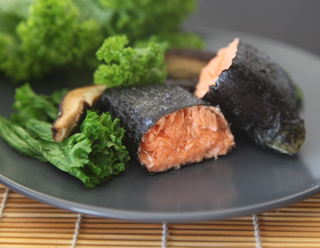 If you’ve cooked fish wrapped in parchment paper before, which gently steams the fish and keeps the flesh moist, this recipe will make total sense. But in this case, instead of parchment, the wrapper is edible, nutritious and delicious.
If you’ve cooked fish wrapped in parchment paper before, which gently steams the fish and keeps the flesh moist, this recipe will make total sense. But in this case, instead of parchment, the wrapper is edible, nutritious and delicious.
Nori, a sea vegetable best known as a wrap for sushi, can also be used to wrap fish while it’s cooking. The nori seals in moisture, keeping the fish juicy and flavorful. This meal is all about moist, tender salmon. When arranged on a plate of sautéed mustard greens and shiitake mushrooms it looks like a rather fancy feast, but there’s no need to be formal. The salmon and nori packages are easiest to eat with your hands.
Although nori isn’t the most nutritious of all the sea vegetables, it still has a respectable amount of minerals and nutrients. Paired with the omega-3s in wild salmon and the powerhouse duo of sautéed mustard greens and shiitake mushrooms, this is a meal that’s hard to beat.
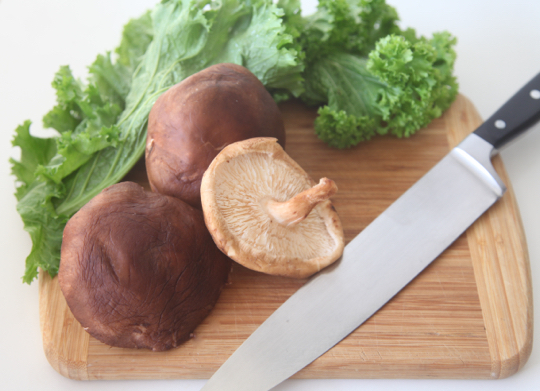
Servings: 2
Time in the Kitchen: 30 minutes
Ingredients:
2 6-ounce salmon fillets, skin and bones removed (170 g each)
2 sheets nori
2 teaspoons plus 2 tablespoons coconut aminos, divided (10 ml + 30 ml)
1 tablespoon extra virgin olive oil, or cold pressed high-oleic/high-stearic sunflower oil, or coconut oil (15 ml)
8 ounces shiitake mushrooms, stemmed, cut into ¾-inch slices (230 g)
2 garlic cloves, finely chopped
1 bunch mustard greens, stems removed and leaves ripped into small pieces
Instructions:
Preheat oven to 450 ºF/232 ºC.
Place each piece of salmon on a sheet of nori. Lightly salt the salmon and drizzle 1 teaspoon (5 ml) of coconut aminos on each fillet. Wrap the salmon in the nori like a package: fold one long end over the salmon then fold in the two shorter sides. Roll the piece of salmon over and tuck the remaining long end under the salmon. Set on an oiled or parchment covered baking sheet, seam side down. (You don’t need to wet the nori; it will adhere to the salmon while it cooks.)
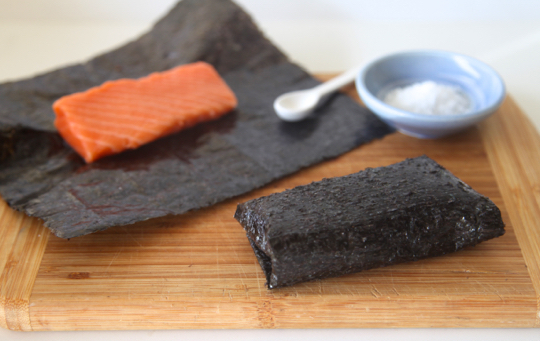
Roast 10 minutes for a ¾-inch/19 mm (or smaller) fillet and 12 minutes for a 1-inch/2.5 cm (or slightly thicker) fillet.
While the salmon roasts, warm oil in a skillet over medium-high heat.
Add shiitakes; season with salt and pepper. Cook, stirring just a few times until lightly browned and soft, about 5 minutes. Stir in garlic and cook for 1 minute, then add mustard greens to the skillet with the remaining 2 tablespoons (30 ml) coconut aminos. Saute, stirring as needed, until the greens are wilted.
Slice the salmon package open and serve on a bed of sautéed greens and mushrooms.
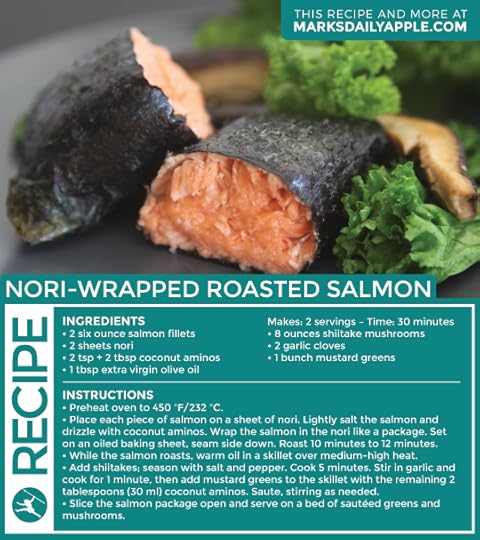
Not Sure What to Eat? Get the Primal Blueprint Meal Plan for Shopping Lists and Recipes Delivered Directly to Your Inbox Each Week



April 24, 2015
Done with Crash Diets: 45 Pounds Lost and Getting Better Every Day
It’s Friday, everyone! And that means another Primal Blueprint Real Life Story from a Mark’s Daily Apple reader. If you have your own success story and would like to share it with me and the Mark’s Daily Apple community please contact me here. I’ll continue to publish these each Friday as long as they keep coming in. Thank you for reading!
 Before I state anything, I just want to thank Jesus Christ for the opportunity of life and the strength to get through this process. Life is truly a gift from God.
Before I state anything, I just want to thank Jesus Christ for the opportunity of life and the strength to get through this process. Life is truly a gift from God.
In every group of friends there is the good looking one, the athletic one, the fun one, the quiet one, and of course, there’s the chunky one. I was always the chunky one.
I spent my entire life fluctuating in weight – gaining during times of stress, then running long distances and starving myself to fit into my suit pants again for weddings. It was a burden not only on my body, but on my bank account, as all my clothes would get tight (thankfully the “fitted” look came back into style).
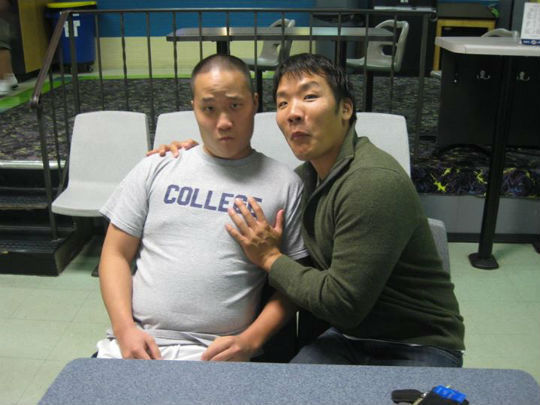
Unfortunately, my favorite foods in life are rice (an Asian staple), soda, pizza, hamburgers, bread, doughnuts, McDonald’s, and any type of dessert. In order to lose weight, I would literally skip meals and run hours on end. I had no idea how much grains and carbohydrates were severely limiting my body shape. For example, I would run 5 miles then drink two sugar-heavy Gatorades, which pretty much would negate my workout. But I had no idea!
Luckily, I randomly read a success story on Mark’s Daily Apple while looking for crash diets online. I was skeptical at first, especially the part about giving up chronic cardio and long distance running, and eating foods with fat, but I was willing to give it a try. Plus, I wanted to impress a girl (it’s always about the girl!) and was the heaviest I had ever been in my life at 210 pounds, at a height of 5’ 8” and a BMI of 31.9 — which meant I was in the “obese” category.
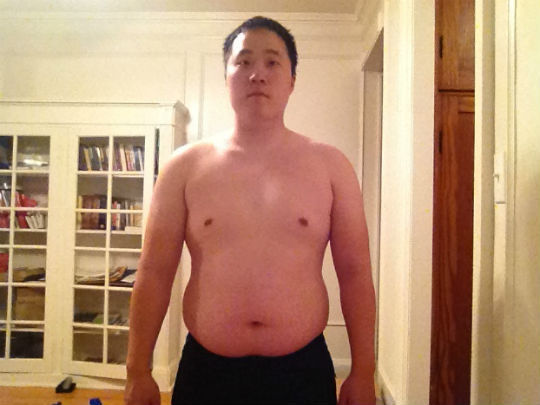
So I set my mind to go all in. I had nothing to lose. I cut my carbohydrates to less than 50 grams per day and increased my caloric intake of fat and protein. That meant no more pizza, hamburgers, soda, rice, doughnuts, bread, pasta, and french fries. I used The Primal Blueprint for all my guidelines (and thankfully the guidelines were free!).
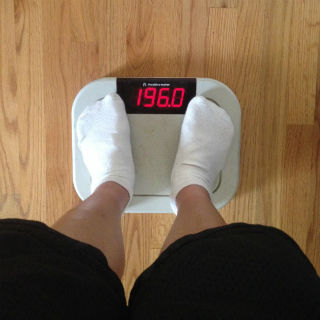 I’m not gonna lie – the first two weeks were absolutely miserable. I think after around seven days I had the notorious “carb flu” and I felt absolutely miserable for a couple days. And I definitely felt like I had lower energy for the first 10 days or so. But it dramatically got better after 14 days, and every day just got easier after that. You just have to pass the first initial hump.
I’m not gonna lie – the first two weeks were absolutely miserable. I think after around seven days I had the notorious “carb flu” and I felt absolutely miserable for a couple days. And I definitely felt like I had lower energy for the first 10 days or so. But it dramatically got better after 14 days, and every day just got easier after that. You just have to pass the first initial hump.
I slowly started to lose weight.
And definitely had days where I failed. (Doughnuts are seriously God’s gift to mankind.)
My typical diet looked like this:
Breakfast: Three to four eggs, over easy.
Lunch: Half a bag of frozen broccoli with protein source (either eggs or fish).
Dinner: Fish or steak, with broccoli or vegetables.
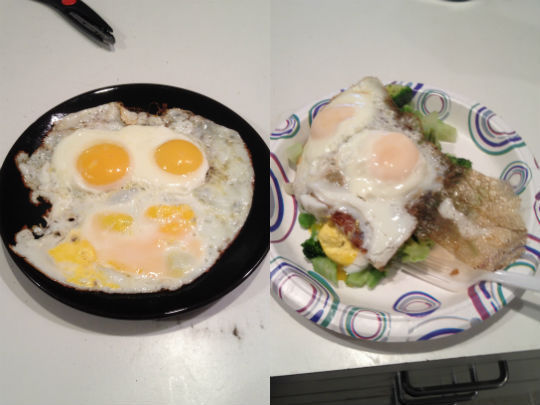
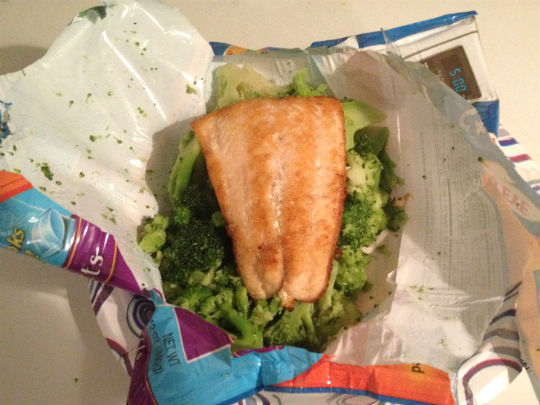
For exercise, I changed from running 30-40 minutes everyday and lifting weights liked I used to, and followed the Primal guidelines – high intensity, shorter time (less than 40 minutes at the gym), interval training, and I sprint one day. I definitely feel stronger and have less chronic pain in my knees. Also, it’s more fun!
Here’s a side by side before and after in 5 months (May 2014 and November 2014):
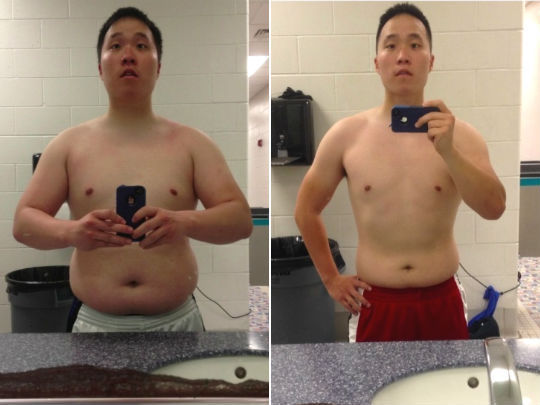
And 10 months, (current):
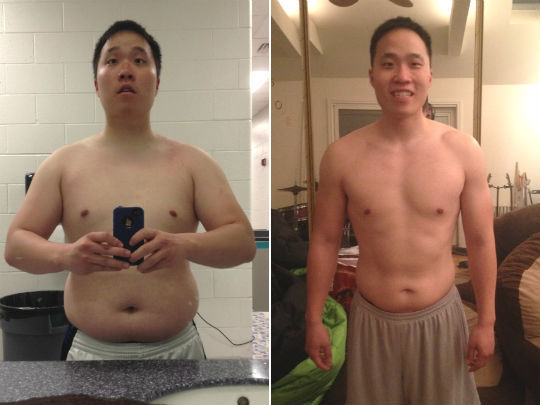
I lost about 45 pounds in five months. I’m currently maintaining around 165 pounds, but I definitely gained some muscle weight. Plus, I easily fit into all my size small clothes!
I feel healthier physically, emotionally, spiritually, and mentally. I don’t have to buy new clothes all the time. And I feel more energized throughout the day. It is amazing how much diet and exercise can affect your entire lifestyle and I truly believe if I can do it, anybody can do it. I will forever be thankful for Mark’s Daily Apple and all the great resources and advice it offers! I 100% can testify that The Primal Blueprint worked for an ordinary guy like me and believe everyone should try it to change their lives forever!
Still working on the girl though. We need a Primal book for that.
Francis




April 23, 2015
How to Get Your (Health) Groove Back
 Maybe it comes in a heavily mirrored changing room as you wonder when you developed back fat. Perhaps you notice that you can’t keep up with your kids on a bike ride around town anymore. You might see it when you have a hard time moving or carrying things you used to. Maybe you wake up one day and realize you never thought you’d experience so many aches, pains and stiffness at such a young age. Perhaps you’ve just known for a long time that you don’t like how you feel anymore.
Maybe it comes in a heavily mirrored changing room as you wonder when you developed back fat. Perhaps you notice that you can’t keep up with your kids on a bike ride around town anymore. You might see it when you have a hard time moving or carrying things you used to. Maybe you wake up one day and realize you never thought you’d experience so many aches, pains and stiffness at such a young age. Perhaps you’ve just known for a long time that you don’t like how you feel anymore.
We get off track for various reasons – illness, parenthood, divorce, death, job change, moving. In probably every case, we didn’t anticipate losing sight of our health, but upheaval (good and bad) can often divert us in ways we don’t expect.
The question becomes, “What next?”
We certainly have the option of going back to sleep, so to speak, and then “waking up” to the fact again when some more dramatic detail shows itself. Alternatively, we can decide it’s time….
Specifically, we can decide it’s time to start feeling good again, time to get our strength and energy back, time to like how we look again, time to not feel limited in everyday life activities, time to reclaim our physical and maybe emotional resilience. It’s just time to get our groove back.
“Getting our groove back” – it’s a phrase that’s thrown around in lifestyle headlines, self-help columns and pep talks for anyone coming out of transition. From the angle of health, however, what does that process look like?
A few weeks ago, I took up the concept of inertia. Certainly, I believe that concept figures into this picture, but I think there’s more than the physical stasis to contend with when we’re talking about, well, groove. To feel like we need to get back in the groove suggests two things: 1) that we’ve been out of it for a considerable while and 2) that something about us has shifted on a deeper level than daily activity schedules or diet.
While we could probably have a pretty entertaining conversation about what constitutes groove even if just for health alone, I’m going to venture that it’s caught up in not just our circumstances (what we’re not doing anymore) but our self-concept (how we feel a disconnect between our health values and our daily lives). The result of this incongruity over time can shift how we feel about ourselves. It can erode our health integrity as well as the personal vision we have for our lives. We realize we’re not living in alignment with our values or that we’re forgoing the health related benefits that matter to us. Getting back in the groove, in that sense, means reclaiming our self-identity as well as vitality.
Are you looking to get back into the groove? Have you done so in the past – or are you in process? Let me offer some considerations – and invite everyone to add their experience, questions and perspective in the comment board.
Invest in your self-concept.
When you’ve taken an extended hiatus (however unintentional) from health investment, for most people it’s not enough to simply jump back into practical strategy. Yes, the action is where it’s at, but we’re for better or worse steering our minds as well as our bodies back into a new/renewed way of being.
In these cases, it’s not about returning to what was. It’s also not about emulating and doing what someone else is doing. More than just adopting a routine, getting back into the groove obliges us to move into a new relationship with our health. That means being honest about how we see ourselves these days. What’s happened to us since the last time we were living well, and how have the stories we tell ourselves changed in that time period? Do we have as much confidence in our self-discipline? Are we circumscribing our sense of physical potential in different ways because we’re older than last time we were on the horse?
Be cognizant of – and prepared to work around – the possibility that you may have fundamentally changed.
Depending on how long we’ve been away from our health commitments, our lives might look a fair amount different. Beyond the self-concept piece, this fact may impact strategy and logistics. In other words, trying the same old habits you used years ago to get/stay healthy may not do it anymore. That’s not a bad thing. It’s just information. Be prepared to come up with a new bag of tricks and routines to get you on track.
Do several small things rather than one big thing each day.
While everybody needs to decide what works for them, anytime you’re beginning or beginning again, I’d generally suggest keeping the new routine as doable as possible and front loading as many small wins as you can.
By all means, if you’re a cold turkey, all or nothing person who can totally commit to big changes, go for it. If you’re in any way reticent (or just really busy), break it up into more practical chunks throughout the day.
Engage with people who are living the life you want.
I don’t just mean read a book, listen to a podcast or watch someone at the gym (although these can be helpful, too). Surround yourself with support and modeling. It’s about learning, not comparison. Seek out opportunities to talk to other people who are doing what you know you want – even if they feel ahead of you. They will likely value the chance to help you. Reach out in the virtual world as well by joining an online forum. I think I know one that might be pretty awesome….
Pay tribute to the successes and have fun along the way.
It baffles me sometimes how people will put so much time and effort into long lists and explanations of goals and their respective steps but not consider it worth their time to take pictures or otherwise record what happens after that. Are they afraid of jinxing their own outcomes? Do they not feel they deserve to celebrate anything until they hit some socially identifiable benchmark?
Put aside the goal if you find yourself obsessing, and just revel in enjoying the process. Too often people focus so much on discipline that they forget to feel good about what they’re doing. Combine your commitment to exercise with something adventurous, and take pictures of each endeavor (e.g. album of the trails you hit). As you plan your next vacation, look for active pursuits you’ve always wanted to try. Take pictures of your Primal masterpieces to make your Facebook cadre marvel at your culinary genius. Relishing and celebrating your new choices will go a long way in owning the new direction you’re establishing for your future.
Embrace the mindset of self-actualization – and take time deciding how you want to live that right now.
Be present-oriented but also spend a certain amount of strategic time envisioning the long view. Resist feeling like you have to make everything happen today. The only thing you’re responsible for today is showing up for the intentions you set for this 24-hour period.
That said, make the groove matter by asking what you want out of life in the coming years. What do you want to make of yourself – of your time, of your energy? Get back into the groove not by reinstating the past but by living your way into that future vision through the choices you make and adventures you pursue on a daily/short-term basis.
Thanks for reading, everyone. What are your thoughts and anecdotes about getting back in the groove? Have a great end to the week.




April 22, 2015
What’s So Healthy About Avocado Oil?
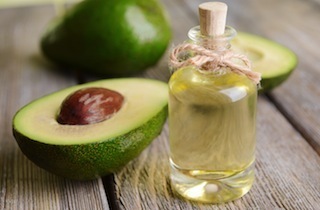 It doesn’t take much digging to figure out that most of the oils we eat in this country are fantastically poor choices. There’s the heavy processing to consider as well as the GMO sourcing, the rancidity, and dramatic omega fatty acid imbalance to name a few unsavory points. Sure, we make different choices in our own kitchens, but sometimes we find ourselves wishing we could recreate a certain taste in a Primal version of an old favorite recipe or just find a better flavor in one of our new favorite Primal meals. As a result, even the most Primally devout among us are on the lookout for the healthiest choices with the right practical adaptability. (And, oh yeah, good taste…) In the interest of relishing our food while respecting our bodies, we hunt down lesser appreciated alternatives. Plus, there’s just something fun about undermining the status quo to support worthy culinary underdogs. One of the great “finds” of my Primal journey has undoubtedly been avocado oil – a little recognized healthy fat with big versatility.
It doesn’t take much digging to figure out that most of the oils we eat in this country are fantastically poor choices. There’s the heavy processing to consider as well as the GMO sourcing, the rancidity, and dramatic omega fatty acid imbalance to name a few unsavory points. Sure, we make different choices in our own kitchens, but sometimes we find ourselves wishing we could recreate a certain taste in a Primal version of an old favorite recipe or just find a better flavor in one of our new favorite Primal meals. As a result, even the most Primally devout among us are on the lookout for the healthiest choices with the right practical adaptability. (And, oh yeah, good taste…) In the interest of relishing our food while respecting our bodies, we hunt down lesser appreciated alternatives. Plus, there’s just something fun about undermining the status quo to support worthy culinary underdogs. One of the great “finds” of my Primal journey has undoubtedly been avocado oil – a little recognized healthy fat with big versatility.
Health Benefits
Aside from the chip and guacamole spread, avocado just doesn’t get the respect it deserves. Consider the fact that an avocado is over 75% fat. For a plant, this is a small and glorious miracle. What this fruit lacks in sweetness, it overachieves in satiety. But let’s look at the fat breakdown.
From an omega standpoint, avocado oil gives you a nutritional profile similar to olive oil. Nearly 70% of avocado oil is oleic acid, a monounsaturated omega-9 fatty acid. Aside from the significant monounsaturated content, avocado oil is about 16% saturated fatty acids and 14% polyunsaturated. The omega-6 to omega-3 ratio is about 13:1. While it’s not an outstanding ratio, the PUFA content itself is small enough (14%) that we’re only talking about a small portion of the total oil. In the grand scheme, it’s as solid as olive oil, with arguably a better taste profile. To boot, the other benefits of avocado oil definitely compensate.
The fats aren’t only healthy in and of themselves but make other nutrients, particularly carotenoids, in the avocado much more bioavailable. Research has shown that avocado or avocado oil increased the absorption of carotenoids in a meal anywhere from 2.6 times to 15.3 times depending on carotenoid.
Speaking of micronutrients, an avocado itself has an impressive nutritional breakdown. A mere half of your average Hass avocado offers goodies such as 345 mg of potassium (that’s more than a banana), 185 μg of lutein/zeaxanthin per one-half fruit, 19.5 mg magnesium, 60 μg folate, 10 mg choline, 19 mg of glutathione, and 57 mg phytosterols including the potent lipid influencer beta-sitosterol.
With their high levels of multiple antioxidants (e.g. polyphenols, proanthocyanidins, tocopherols, and carotenoids), avocados deserve accolades far beyond their usual attention, and research shows that avocado oil confer their nutritional health benefits. Several studies conclude that avocado consumption (again, which is mostly fat/oil) can support everything from good cardiovascular function to healthy aging, better eye health (likely because of enhanced lutein/carotenoid absorption) to easier weight loss (due to satiety), healthier lipid profiles (by lowering LDL and triglycerides) to lower risk for certain cancers (a potential result of glutathione and carotenoid benefits). Avocado oil has also shown benefit for the control of metabolic disorder and liver function.
And free radicals – they meet their match apparently when up against avocado oil. While antioxidants from plenty of other fruits and vegetables are known to neutralize free radicals, research suggests avocado oil’s power might have an extra potent benefit in (unlike most other antioxidant sources) being able to enter mitochondria, our seats of energy production and key factors in aging trajectory.
And while we’re on the subject of aging, avocado oil’s polyhydroxylated fatty alcohols, have been shown to reduce skin damage and inflammation that result from ultraviolet light exposure. These unique lipid molecules in addition to avocado oil’s effect on carotenoid absorption mean potent protection for the skin cell integrity and overall skin health.
Adaptability and Taste
Avocado oil is pressed from the pulp of the fruit rather than the seed. Because of its particular fat ratios, extra virgin avocado oil has a high smoke point of 400°F (204°C). This makes it extremely adaptable in the kitchen for anything from sautéing to stir-fry, baking to salads.
Unlike the sometimes bitter taste and pungent scent of olive oil, avocado oil has a mild smell, a creamy texture and rich, lingering taste that’s both naturally buttery and slightly nutty. (To my nose, the oil smells like a soft, ripe avocado with maybe a very faint hint of artichoke.) It’s become my favorite oil for fish, grilled vegetables and a lot of salad recipes.
Because of the higher smoke point, you can use avocado oil in cooking marinades as well as finishing sauces. I know people who avoid all dairy and use this oil in lieu of butter (or even ghee) for most of their cooking. Oh, and I’ve also heard the mild, neutral taste and high monounsaturated profile make it the perfect oil for Paleo mayo… (wink).
And while I don’t do much baking, I’ve heard from many who have come to appreciate avocado oil in recipes, particularly when they’re not looking for the strong aroma that unrefined coconut oil inevitably adds.
The only “con” you could say is the relative rarity of avocado oil. While you may not find it in every mainstream grocery store in the Crisco aisle, many if not most co-ops as well as specialty or higher-end grocers carry it. There are also many online markets that offer avocado oil at a reasonable price – and (of course) Primal Kitchen™ Mayo from my favorite, Thrive Market.
Have you used avocado oil? What Primal recipes have you found it a good complement for? Share your thoughts and cooking ideas in the comment board, and thanks for reading today, everyone. Have a great week.




April 21, 2015
Essential Oils: Separating Fact from Fiction
 If you spend a day or two on social media sites, you get the idea that essential oils are a panacea that can replace every modern medicine, both over the counter and prescription. Kid got a fever? Rub a little of this oil on his feet. Big job interview coming up in a few minutes? Inhale a little of this to relax. Fungal infection? Splash some of this on. It’s gotten particularly out of hand on Pinterest, where multi-level marketing schemers attempt to convince everyone they absolutely need to become essential oil wholesalers. Conversely, if you hang around in the online skeptic communities (Science Based Medicine, Quackwatch, etc.), you come away with the impression that essential oils are at best pleasant-smelling placebos and at worst expensive poisons. So – who’s right? Who’s wrong? Are essential oils simply glorified air fresheners without any evidence of efficacy, or does the truth lie somewhere between the two extremes?
If you spend a day or two on social media sites, you get the idea that essential oils are a panacea that can replace every modern medicine, both over the counter and prescription. Kid got a fever? Rub a little of this oil on his feet. Big job interview coming up in a few minutes? Inhale a little of this to relax. Fungal infection? Splash some of this on. It’s gotten particularly out of hand on Pinterest, where multi-level marketing schemers attempt to convince everyone they absolutely need to become essential oil wholesalers. Conversely, if you hang around in the online skeptic communities (Science Based Medicine, Quackwatch, etc.), you come away with the impression that essential oils are at best pleasant-smelling placebos and at worst expensive poisons. So – who’s right? Who’s wrong? Are essential oils simply glorified air fresheners without any evidence of efficacy, or does the truth lie somewhere between the two extremes?
Let’s first dig into the common claims and the evidence for some of the most popular essential oils.
Peppermint Oil
Reduces fever when applied to feet.
Any truth? I couldn’t find any published research that supports this claim, unless you’re talking about reducing dengue fever; peppermint oil apparently repels dengue fever-carrying mosquitos.
Stimulates hair growth.
Any truth? A 2014 animal study found that compared to saline, jojoba oil, and minoxidil, topical peppermint oil stimulated the most hair growth with an increase in dermal thickness, follicle number, and follicle depth. Also, there were no “toxic signs,” which is always good.
Relieves and even cures IBS.
Any truth? It’s mixed. Some research shows that peppermint oil can reduce overall IBS symptoms, but a recent placebo-controlled trial found that while peppermint oil relieved transient abdominal pain in IBS, it had no effect on any of the other IBS symptoms. An earlier study supports its use in IBS-related stomach pain, showing that enteric coated peppermint oil capsules improved pain symptoms in kids with IBS.
Rosemary Oil
Prevents and reverses male pattern baldness when applied topically.
Any truth? One recent study compared minoxidil (an over the counter hair loss treatment) to rosemary essential oil. Both were rubbed into the scalp on a daily basis. At six months, both groups had experienced a significant increase in hair growth, with the rosemary group having slightly less itchy scalps.
Energizes, fights fatigue.
Any truth? In twenty healthy volunteers, inhaling rosemary oil increased blood pressure, heart rate, and respiratory rate. Subjective impressions of stimulation increased, with subjects reporting feeling “fresher.” Alpha brain wave activity (as measured by EEG) diminished and beta wave activity increased, indicative of “stimulation.” However, there was no placebo control group.
Improves memory.
Any truth? A 2013 study placed subjects in one of two rooms — one with a diffuser emitting rosemary essential oil and one with no diffuser — and gave both groups memory exercises to complete. Those in the rosemary room performed better and, according to blood tests taken after the exercises, had higher serum levels of a unique rosemary phenolic compound. Since previous animal studies have shown rosemary compounds interact with memory systems in the brain, the relationship may be causal and indicative of rosemary oil’s efficacy.
Lavender Oil
Reduces anxiety.
Any truth? Well, in coronary bypass surgery patients, lavender oil was able to reduce anxiety, but no more than the placebo control. However, in dental patients, lavender oil aromatherapy reduced anxiety, while the placebo did not; other studies confirm this effect in dental patients. Oral lavender oil seems just as effective (without the side effects, like drowsiness and extreme addiction) as xanax at reducing general anxiety. It’s mixed, then, but I think the evidence is fairly strong that lavender oil can reduce anxiety in people. Germany, for example, has deemed oral lavender oil a legitimate treatment for anxiety disorders.
Reduces migraines.
Any truth? There is one study that found lavender oil to be effective against acute migraine, but the control was a plain paraffin wax candle. Paraffin wax is a petroleum byproduct and potential migraine trigger for some people, so this may not have been an inert control.
Increases vasodilation.
Any truth? In human hospital workers, lavender aromatherapy limits the reduction in flow-mediated dilation that normally accompanies a night shift.
Orange Oil
Reduces anxiety.
Any truth? In pediatric dental patients, orange oil aromatherapy lowered cortisol and pulse rate; similar reductions in anxiety were found in adult female patients. And when they were exposed to orange oil aromatherapy, human subjects undergoing experimental stress experienced very few alterations to stress parameters. Tension, tranquility, and systemic anxiety were all relatively unchanged. It works in rats, too.
Treats acne when applied topically.
Any truth? A 2012 trial found that a face gel based on orange oil, sweet basil oil, and acetic acid applied daily for 8 weeks improved acne symptoms.
Tea Tree Oil
Boosts the immune system.
Any truth? “Boosts the immune system” is fairly non-specific and vague, but there may be something. In rats infected with a pathogenic protozoa, oral tea tree oil extended their lives and modified the immune response but did not cure them.
Heals skin cancer.
Any truth? An animal study used topical tea tree oil mixed with DMSO (a solvent that allows anything it’s mixed with to penetrate the skin) to induce cytotoxicity in skin tumors. An earlier study using the same tea tree oil/DMSO solution was able to inhibit the growth of established skin cancer cells.
Kills oral pathogens.
Any truth? In a recent trial, tea tree oil mouthwash performed poorly at reducing plaque compared to cetylpyridinium mouthwash and commercial chlorhexidine. An earlier study found tea tree oil had beneficial effects on gingivitis, but not plaque. Tea tree oil does have significant anti-microbial action against common oral pathogens in an in vitro setting, so the potential is there.
The evidence is mixed, as you can see. Essential oils are just mediums for the essence of the plant, and there are thousands of different plants out there; it really depends on what claim and what plant we’re talking about. The evidence for peppermint oil reducing fever may be nonexistent, but that doesn’t necessarily mean peppermint oil is useless against IBS pain and hair loss. Just because your annoying neighbor keeps harping on you to join her MLM empire selling chakra-triggering oil blends doesn’t preclude those same blends from helping you relax —physiologically — at the end of a long day.
Essential oils often do work and actually can improve certain conditions, but they’re victims of their promoters. The testimonials are too breathless to be believed. The evidence they submit is too anecdotal. If they refer to a study when making a claim, it’s usually misrepresented or includes a half dozen oils that make analysis of the specific oil impossible. Plus, the arguments or recommendations they offer often contradict each other. The evangelists ruin it for the science-minded health explorers who might actually benefit from essential oils.
Essential oils as a whole do have evidence of efficacy in a few key areas:
Anxiety and stress: Aromatherapy is quite effective at reducing stress and anxiety. I already mentioned the ability of lavender and orange oils to reduce anxiety, but plenty of other oils have shown efficacy as well. In healthy females, bergamot essential oil increased parasympathetic activity and lowered salivary cortisol. Bergamot works in anxious rats, too. Transdermal application absent aroma detection may also be effective against anxiety and stress, as one study using topical rose oil showed. Most of the citrus oils (PDF), like the aforementioned orange and bergamot as well as lemon and bitter orange all show anxiolytic effects, probably due to limonene, an anxiolytic compound found in all of them.
Antibiotic activity: As a whole, essential oils tend be potent antimicrobial agents. The parent plants have a vested interest in repelling bugs, fungus, bacteria, and other tiny critters with designs on them, and this motivation manifests in their essential oils. In addition, they usually have the ability to break down and disrupt microbial biofilms, those stubborn microbe matrices that can resist many standard antibiotics. Clearly, more research is needed before essential oils can replace antibiotics, but it’s a conversation that we desperately need to pursue given the current state of antibiotic resistance and antibiotic overuse in human medicine and agriculture.
Dental health: Given their antibacterial activity, many essential oils have potential in dental health. Tea tree oil, manuka oil, and eucalyptus oil all displayed antibacterial effects against common oral pathogens in one study, while other research has shown that thyme and oregano essential oils also show efficacy.
Nausea: Lemon essential oil inhalation can reduce pregnancy-associated nausea and vomiting, and a 2012 review found that both ginger and peppermint essential oils were also effective (though they did identify some methodological concerns). For post-operative nausea, both ginger oil and a blend of ginger, cardamom, spearmint, and peppermint oils may help.
So, what’s the final verdict on essential oils? Bunk or boon?
It’s complicated. It’s tough to give a single opinion that applies to dozens upon dozens of unique essential oils. But we can say a few things that apply to all of them.
Essential oils are not inert placebos. They’re not expensive air fresheners. They are pharmacological agents with bioactive compounds, many of which are powerful enough to rival prescription drugs. But with this power comes randomness. As much as we harp on pharmaceuticals for the unwanted side effects we often counter using another prescription, at least the dosages of the active ingredients are stable and constant. Essential oils? Not so much. There’s no real way of knowing the “dosage” of the bioactive compound, or even whether we’ve successfully uncovered every possible compound present in the plants, herbs, and spices used to make the oil.
Essential oils are also not harmless. For example, topical essential oils can be quite harsh and even toxic. When exposed to air, lavender oil forms strong contact allergens, and compounds in lavender oil have cytotoxic effects on human skin cells. Topical orange oil is a “very weak” promoter of skin cancers.
It’s clear that some essential oils work for some things, while others don’t. And the ones that don’t work for one claim might very well work for another. As I said: it’s complicated.
What about you, folks? Any essential oil users out there? What do you swear by? What do you recommend? Or are you totally convinced that there’s nothing going on here?
Let’s hear about it in the comment section!




April 20, 2015
Dear Mark: Fish Oil Study, 1500 Calories, Breaking a Plateau, and Bulletproof Coffee vs IF
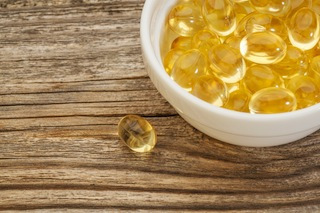 For today’s edition of Dear Mark, I’m answering four questions. First up is from Milad, who wonders about the recent research seeming to show that fish has little to no effect on heart disease. Is it right? Are we wasting money and enduring fish burps for nothing? Next, how low is too low? If a person’s eating 1500 calories and feeling completely satisfied, should he preemptively increase calories before bad things start happening? After that, I give a couple tips for breaking through a weight loss plateau. And last, how does Bulletproof coffee “fasting” compare with actual intermittent fasting? Is it a better alternative?
For today’s edition of Dear Mark, I’m answering four questions. First up is from Milad, who wonders about the recent research seeming to show that fish has little to no effect on heart disease. Is it right? Are we wasting money and enduring fish burps for nothing? Next, how low is too low? If a person’s eating 1500 calories and feeling completely satisfied, should he preemptively increase calories before bad things start happening? After that, I give a couple tips for breaking through a weight loss plateau. And last, how does Bulletproof coffee “fasting” compare with actual intermittent fasting? Is it a better alternative?
Let’s go:
Hey Mark,
Long time reader and fan so I’ll keep this short:
Fish Oil Not So Perfect After All
That, which you may have already seen. Observational study?
Cheers,
Milad
Thanks, Milad. They only examined patients who either had heart disease or had a confluence of risk factors for it, like hypertension, high cholesterol, and/or type 2 diabetes. In other words, these were people who were already being treated for heart disease. They were on statins, blood thinners, beta blockers. They were on special diets. They were receiving advice and careful monitoring from health professionals.
A more recent paper found that in subjects who weren’t taking any lipid-lowering medication, fish oil supplementation improved biomarkers related to heart disease risk. These biomarkers were extensive and indicative of actual physiological mechanisms, mind you. They weren’t just the usual “LDL and HDL” measurements. Patients taking fish oil had lower “very low-density lipoprotein cholesterol, intermediate-density lipoprotein cholesterol, remnant lipoproteins, triglycerides, low-density lipoprotein cholesterol, AtherOx levels, collagen-induced platelet aggregation, thrombin-induced platelet-fibrin clot strength, and shear elasticity.”
I suspect fish oil has very different effects depending on your baseline treatment status. Fish oil works for heart disease, in part, by reducing hypertension, lowering blood lipids and inflammation, and thinning the blood. If you’re already taking drugs that reduce inflammation and cholesterol (statins), hypertension (beta blockers), and thin the blood (warfarin), fish oil may have reduced or even negative effects. The benefit of going with fish oil, or at least working with your doc to try fish oil before going with the meds, is that you avoid the considerable side effects that accompany statins.
And even if fish oil and omega-3s in general are useless for heart disease patients (they are not), they’re still beneficial in other situations. A few examples:
Reducing perceived and objective markers of stress in 3rd trimester women.
Reducing depressive symptoms and lowering inflammation in hemodialysis patients.
Improving ADHD symptoms in kids.
Improving skin resistance to sun damage.
Obviously, the best way to obtain omega-3s and many other protective nutrients is through seafood consumption, but a good quality fish oil is a worthy substitute when you can’t get good fish.
Hi Mark,
I love the research you put into your posts; it is far more reassuring trusting your advice when you back it with research and science.
Now, I used to be overweight, but I have recently switched over to a cleaner diet – based on your concepts, thank you! – but I eat a ton of vegetables with every meal and my daily caloric intake averages about 1500 calories because of it (I am a 5’9″ 190 pound guy). So my problem is that I always feel full but my logic tells me I should be eating more. Is this healthy?
Dan
At 5’9″ and 190, you probably still have some excess weight to lose (unless you’re a powerlifter type), and that partially explains why you feel good on such a low calorie intake. You’re consuming ample amounts of animal fat calories drawn directly from your body. And since you’re eating tons of vegetables, you’re probably getting all the micronutrients you need. This contributes to your satiety levels and will stave off many of the health issues normally associated with low calorie diets (which usually turn out to be low nutrient diets).
You’re okay as long as you feel okay. You say you “feel full.” Do you feel good? Do you have enough energy, or do you feel like you’re lagging halfway through the day? How’s your sleep? How’s your performance in the gym (or wherever you get your activity)? Do you feel mentally sharp? Are you in a generally good mood, or at least as good a mood as you were before going Primal?
Then you’re okay.
Just be vigilant and stay aware of how you’re feeling before it gets out of hand. You’re obviously thinking about this stuff pretty deeply, so I’m not really worried about you. Keep me posted, though!
Hey Mark,
I have been eating primal for a solid month now. I dropped a great deal of weight in the first two weeks. Almost 20 pounds! Now I have approached the end of the month and in the last two weeks I haven’t lost another pound! In these past two weeks I have been eating super clean and keeping it strictly to proteins, vegetables and healthy fats. Any insight as to why this is happening, or how to break through this plateau?
Thanks,
Kelly
Plateaus sometimes just happen. It could be the calm before the storm, and you’re about to be hit with another round of fat loss. So there’s that. You may not have to do anything extra but continue on, sit back, and let it happen.
But often you do have to actively bust a plateau. In those cases, I recommend two things to try before anything else. The first, and most effective? Sprinting.
Sprinting isn’t necessarily the best fat burning lifestyle intervention, but it’s usually the one that kickstarts lagging weight loss. It’s the one that most people are missing. Because, let’s face it: sprinting is kind of scary. For those of us with a history of injuries or bad knees or any sort of soft tissue issue, lining up on a track and sprinting straight ahead is risky and daunting. You can get hurt doing it. You can’t just launch into an all-out sprint cold and hope to come out with everything intact. Most people just don’t know how to sprint because they haven’t done it since they were kids.
Make sure you’re sprinting right. Make sure you’re up on the 19 tips, tricks, and hints for sprinting safely, effectively, and without injury I laid out last year. Make sure you’re practicing mobility work to support optimal movement and tissue health.
Sprinting doesn’t have to be done on a track. You can sprint uphill, which is easier on the joints (and arguably better for fat loss since you’re working against gravity). You can sprint on a beach, which I enjoy.
Sprinting doesn’t have to mean running. You can sprint on a stationary bike. You can sprint in the pool. You can sprint on the Versa-climber, which is my favorite cardio machine of all time and what I use if I can’t run actual sprints. You can also do sprints on the rowing machine or the elliptical. The key is moving really, really quickly for a short period of time.
The second thing to try is a carb refeed. I explained it all in a post, but (long story short) a refeed involves once or twice a week going very low fat and high carb. And by high carb I don’t mean 600 grams. I mean more like 250-300 grams, preferably consumed on a training day to boost insulin sensitivity and restore depleted glycogen. This can raise lagging leptin levels, which increases energy expenditure and reduces appetite, thus promoting fat loss.
Give both a shot and let me know how it goes. Good luck!
Hello Mark,
I am a huge fan and I’ve been looking to implement intermittent fasting as an attempt to restart my weight loss. I want to know if I can get the same benefits from Intermittent fasting if I consume Bulletproof coffee in the morning. The MCT and butter helps me get past the hunger but I want to know if these extra calories reduce the benefits.
Keep up the great work!
Thanks,
Dan
Well, it’s certainly not fasting. A half stick of butter and a couple tablespoons of MCT or coconut oil is a lot of calories, and fasting by definition requires the absence (or at least near absence) of calories. Drinking 600+ calories every morning versus drinking zero calories? As far as weight loss goes, the latter option will work better.
A lot of people swear by the BP coffee thing. I’ve never really liked it for myself, not because I disagree with butter and coconut oil in coffee (it’s quite tasty), but because it’s just too much of everything at once. Especially if done every morning. It may be sacrilege among some of you, but I seriously question whether Bulletproof coffee is a good idea on a daily basis. It’s just a huge, unremitting influx of energy that seems a bit too excessive and absent evolutionary precedent for me to be completely comfortable with daily consumption.
Maybe if you’re on a full-blown ketogenic diet and it’s the easiest way for you to eat enough fat. But for the average person on a regular Primal eating plan who likes to eat a wide variety of plant foods and food in general? All those calories you’re mainlining with the coffee in the morning will probably crowd out the other stuff you like to eat.
Go for it if you enjoy it and get good results. But don’t stick with it if you’re gaining weight, feeling nauseated, or any of the other side effects I’ve seen in people (in our own office) consuming Bulletproof coffee (the butter/oil concoction, not the beans) on a daily basis.
Don’t get me wrong: I’m not bashing butter in your coffee. But I’d prefer people think of it as a treat to be enjoyed a couple times a week, rather than a meal replacement or a daily staple. It’s a tool. Hard day of work coming up? Get out the blender and the butter. Just another morning? Maybe make your coffee black and do some eggs, sautéed greens, and a bowl of berries instead for more nutrients, some actual protein, and far fewer calories.
By all means, try both regimens out (fasting and BP coffee) to see what works, but I suspect you’ll have more success with true fasting and intermittent, rather than chronic, BP coffee consumption.
That’s it for this week, everyone. Thanks for reading and be sure to leave a comment with your input down below!




Mark Sisson's Blog
- Mark Sisson's profile
- 199 followers



